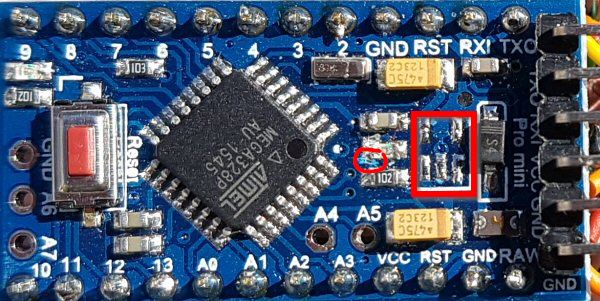|
Build an ultra low power LED Christmas Icicle that runs for weeks on a button battery
This started out as an investigation into how long I could run an Arduino on a small battery and still get it to do something useful. I had to choose the right Arduino board and figure out how to use the 'SLEEP_MODE_PWR_DOWN' mode.
With a little bit of gentle hacking of an Arduino Pro-Mini, editing a file in the Arduino IDE and flashing the fuses in the Arduino I managed to get the power consumption down to less than 5µA. At this level a 3v Button Cell should last for years but I still needed to make it do something.
"A christmas decoration" I said. I will make an LED icicle that drips every few seconds. Perfect I thought. I had seen such decorations while on a winter break last year. They hung over many of the pathways where we were staying and they looked very effective. But they were all wired and powered by 12v which isn't very convenient for around the home. That's when I first thought of the idea of a battery powered icicle.
Why the Pro-Mini?
Well it's small and it has no power hungry USB interface to suck life out of the battery. The two components that do consume significant power are the power-on LED and the voltage regulator. Both of these are easily removed. The Pro-Mini seems a good choice for this application.
The icicle drip decoration
The image to the right shows the icicle caught in mid drip. It consists of 6 bright white LEDs set to flash quickly in sequence every 8 seconds. The 'drip' starts with a flash from the top LED then the top two LEDs flash followed by the second LED then the second and third etc. The whole sequence from top to bottom lasts about 300ms.
If the modified Pro-Mini was left in 'SLEEP_MODE_PWR_DOWN' mode permanently consuming 5µA then it should last well over two years on a 3v 160mA/h button cell.
If the LEDs flash for a total of 300ms and they draw 1mA while doing it every 8 seconds then that is an average of 0.3/8 = 37.5µA. While it is active the Pro-Mini itself uses 3.58mA which works out to an average of 134µA. With 5µA for the Pro-Mini in sleep mode it all adds up to 172µA.
A 160mAh button battery with 100mAh usable energy would last 100/0.172 = 581 hours or 24 days.
My icicle finally stopped dripping after 23 days which is pretty close to what I had predicated. You can adjust the sketch to make it last longer by reducing the length of the flashes or increasing the time between drips. You could also use two AA or larger batteries if you wanted it to go for a very long time.
If you instead were to use two Alkaline AA cells with a capacity of 1200mAh then you should expect 9 months worth of flashing icicle.
Click here to find out how to modify the Pro-Mini for ultra low power operation
| 







Comments (2)
Add Comment